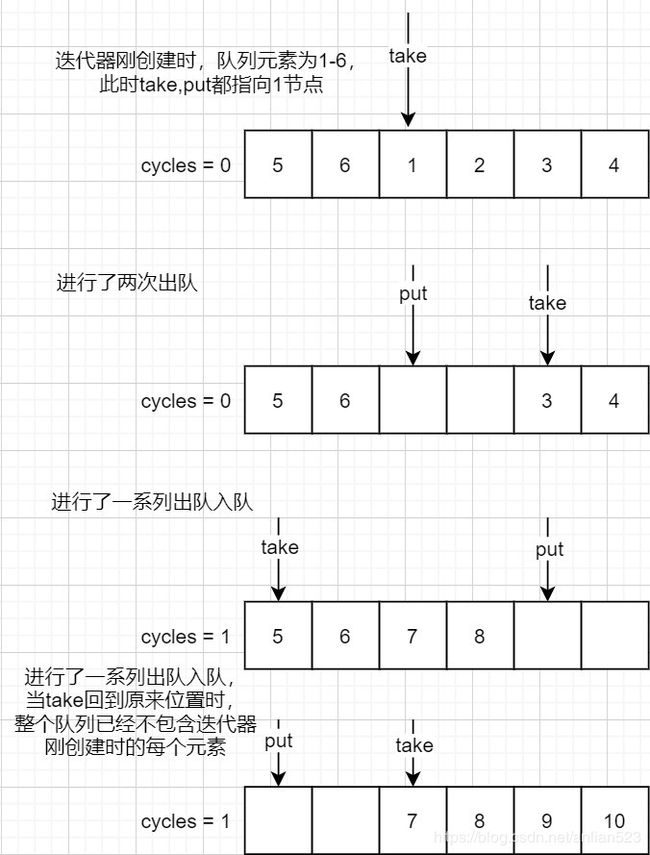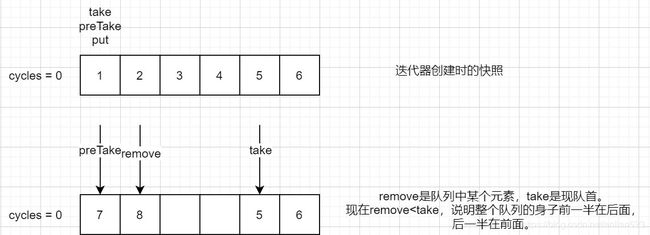JDK8 ArrayBlockingQueue迭代器 源码解析
文章目录
- 前言
- Itr成员
- Itr构造器以及public方法
- Itrs对Itr的管理
- ArrayBlockingQueue里对Itrs的调用
- itrs.elementDequeued()
- itrs.removedAt(removeIndex)
- 为什么Itrs会去掉失效的迭代器
- 总结
前言
ArrayBlockingQueue的迭代器也是弱一致性的,体现在于队列元素被删除后,迭代器的next()也会照常返回这个元素。
Itr成员
/** Previous value of takeIndex, or DETACHED when detached */
private int prevTakeIndex;
/** Previous value of iters.cycles */
private int prevCycles;
这两个成员在创建迭代器时候被赋值,它用来保存创建时队首的快照。

- 从上图可以看出,即使take完全一样,和当初创建迭代器的队列相比,现在整个队列已经不包含迭代器刚创建时的每个元素了。
- 开始时:
cycles = 0 takeIndex = 2。结束时:cycles = 1 takeIndex = 2。通过前后两种情况得知,整个队列已经不是当初那个队列了。 - 如果你在开始时,持有一个索引位置的元素。在结束时,无论你那个索引是啥,你持有的那个元素肯定已经过时了。
/** Index to look for new nextItem; NONE at end */
private int cursor;
/** Element to be returned by next call to next(); null if none */
private E nextItem;
/** Index of nextItem; NONE if none, REMOVED if removed elsewhere */
private int nextIndex;
/** Last element returned; null if none or not detached. */
private E lastItem;
/** Index of lastItem, NONE if none, REMOVED if removed elsewhere */
private int lastRet;
迭代器调用next就返回一个元素,但ArrayBlockingQueue的迭代器是在调用next之前就准备好nextItem。所以,在迭代器初始化、每次调用next时,都会准备好next相关数据,以便下一次next调用时可以直接返回nextItem。

- 迭代器初始化时,准备好了next的两个成员,都是指向的1节点。
- 第一次调用next()时,队列已经改变,但还可以继续遍历下去。虽然此时1节点已经被删除,但既然已经准备好了,那还是返回1节点。只是之后调用remove()将不会执行删除动作了,因为1节点已经被删除了。
- 因为队列已经改变,next的两个成员需要从新的队首开始。
Itr构造器以及public方法
Itr() {
// assert lock.getHoldCount() == 0;
lastRet = NONE;//刚初始化肯定没有调用next返回过,所以lastRet赋值为NONE
final ReentrantLock lock = ArrayBlockingQueue.this.lock;
lock.lock();//先获取锁,避免此时有并发的队列修改
try {
//如果队列为空
if (count == 0) {
// assert itrs == null;
cursor = NONE;
nextIndex = NONE;
prevTakeIndex = DETACHED;//将迭代器标记为失效状态
//如果队列不为空
} else {
final int takeIndex = ArrayBlockingQueue.this.takeIndex;
prevTakeIndex = takeIndex;//保存快照的一部分
nextItem = itemAt(nextIndex = takeIndex);//准备好next的两个成员
cursor = incCursor(takeIndex);//cursor就是nextIndex的后继索引
//全局管理迭代器的相关操作
if (itrs == null) {
itrs = new Itrs(this);
} else {
itrs.register(this); // in this order
itrs.doSomeSweeping(false);
}
prevCycles = itrs.cycles;//保存快照的另一部分
// assert takeIndex >= 0;
// assert prevTakeIndex == takeIndex;
// assert nextIndex >= 0;
// assert nextItem != null;
}
} finally {
lock.unlock();
}
}
如果队列为空,那么创建出的迭代器就是失效的。看看队列非空的情况吧:
- lastRet最开始就设置为NONE,因为刚创建还没有调用过next()呢。
- nextIndex、nextItem都根据当前的队首来设置。
- cursor则为nextIndex的后继索引,具体看
incCursor的逻辑,其实就是索引按照循环数组的方式右移,但不能到达putIndex。 - prevCycles、prevTakeIndex根据当前队列的队首,存储快照信息。
private int incCursor(int index) {
// assert lock.getHoldCount() == 1;
if (++index == items.length)
index = 0;
// 遍历范围是[takeIndex, putIndex),所以到达putIndex时,设置为无效值
if (index == putIndex)
index = NONE;
return index;
}
public boolean hasNext() {
// assert lock.getHoldCount() == 0;
// 此方法不用加锁,因为队列的改变不会影响nextItem
if (nextItem != null)
return true;
// nextItem为null
noNext();
return false;
}
hasNext()不用加锁,因为队列的改变不会影响nextItem,这也意味着迭代器不会在乎nextItem在队列是否被删除,下一次必定会返回。
public E next() {
// assert lock.getHoldCount() == 0;
final E x = nextItem;//不管怎样,必定返回它
if (x == null)
throw new NoSuchElementException();
final ReentrantLock lock = ArrayBlockingQueue.this.lock;
lock.lock();
try {
if (!isDetached())
incorporateDequeues();//先按照当前快照检查各个索引成员是否过时,然后更新快照
// assert nextIndex != NONE; 检查索引成员后,它要么是个正数,要么是REMOVE
// assert lastItem == null; next()返回了最后一个可遍历元素后,它才可能非null
lastRet = nextIndex;//如果没被检查赋值为REMOVE,那这里就是正数
final int cursor = this.cursor;//暂存检查后的cursor
if (cursor >= 0) {//检查后还是正数,那么通过它获得next相关成员
nextItem = itemAt(nextIndex = cursor);
// assert nextItem != null;
this.cursor = incCursor(cursor);//前进cursor
} else {//如果是负数,不是因为incorporateDequeues干的,而是上一次的next()的incCursor干的
//说明此次next()返回的是最后一个可遍历元素,所以把next相关成员设为无效值
nextIndex = NONE;
nextItem = null;
}
} finally {
lock.unlock();
}
return x;
}
- 不管怎样,之前保存的nextItem肯定会返回。只要它非null。
- 各个索引成员会收到
incorporateDequeues的检查,它们可能改变。 - 将nextIndex赋值给lastRet,将cursor赋值给next的两个成员,再右移cursor。
- 右移cursor时,可能导致cursor更新为NONE,这代表下一次next()返回的最后一个可遍历元素。
isDetached()只是当prevTakeIndex == DETACHED时返回true,上一段也说了,除非到了最后,isDetached()是不可能返回true的。所以我们直接看incorporateDequeues是如何检查索引的。
private void incorporateDequeues() {
// assert lock.getHoldCount() == 1;
// assert itrs != null;
// assert !isDetached();
// assert count > 0;
final int cycles = itrs.cycles;
final int takeIndex = ArrayBlockingQueue.this.takeIndex;
final int prevCycles = this.prevCycles;
final int prevTakeIndex = this.prevTakeIndex;
//如果和最新队首快照不一样,那说明这期间出队过
if (cycles != prevCycles || takeIndex != prevTakeIndex) {
final int len = items.length;
// 得到新旧队首之间出队了多少次,通过循环数组的计算方式
long dequeues = (cycles - prevCycles) * len
+ (takeIndex - prevTakeIndex);
// Check indices for invalidation
if (invalidated(lastRet, prevTakeIndex, dequeues, len))
lastRet = REMOVED;//已经返回的,置为REMOVED
if (invalidated(nextIndex, prevTakeIndex, dequeues, len))
nextIndex = REMOVED;//即将返回的,也置为REMOVED
if (invalidated(cursor, prevTakeIndex, dequeues, len))
cursor = takeIndex;//cursor当前不会返回,所以更新为最新队首
//此函数中不可能让cursor为0,因为最多可能赋值为ArrayBlockingQueue.this.takeIndex
if (cursor < 0 && nextIndex < 0 && lastRet < 0)
detach();//使迭代器失效
else {//否则更新迭代器的队首快照
this.prevCycles = cycles;
this.prevTakeIndex = takeIndex;
}
}
}
回忆最开始讲解队首快照的地方,dequeues现在就是新队首相对旧队首的移动次数(也就是出队次数),只要dequeues >= length,那么很显然,之前持有的任何索引都会过时。
incorporateDequeues的最后,除非迭代器失效,那么一定会更新 新队首快照的。
//检查传入index参数,相对于旧队首的移动次数
private boolean invalidated(int index, int prevTakeIndex,
long dequeues, int length) {
if (index < 0)
return false;
int distance = index - prevTakeIndex;
if (distance < 0)//说明index从循环数组的另一端出来了,但我们需要得到正数
distance += length;
//如果 新队首相对旧队首的移动次数 > index参数相对于旧队首的移动次数,
//说明从旧队首变成新队首的期间,index参数已经过时
return dequeues > distance;
}
现在任何索引相对于旧队首的移动次数都必定是< length的(从队首出发移动到队尾,移动次数也只有length - 1)。
- 如果
dequeues >= length,那么此invalidated函数肯定返回true,因为整个队列相对上一次的快照已经完全不一样了。 - 如果
dequeues < length,那么真假都可能返回。因为队列中尚且存有上一次快照的某几个元素(当然,极端情况是,和上一次快照一模一样)。
之前提到,最后一次调用next()后,再调用一次remove()或者hasNext()才能让迭代器失效(prevTakeIndex == DETACHED)。假设最后一次调用next()后的状态为:
- cursor为NONE。
- nextItem、nextIndex都为无效值(null、NONE)。
- lastRet为正数(假设最后一次调用next()时,通过
incorporateDequeues检查发现nextIndex没有被删除,所以lastRet = nextIndex赋值的是正数。相反,如果通过incorporateDequeues检查发现nextIndex已经被删除,lastRet = nextIndex赋值的会是负数,这种情况分析会更简单,所以不需要讲解,看前一种情况即可)。
先看下调用hasNext()接下来会发生什么:
public boolean hasNext() {
// assert lock.getHoldCount() == 0;
// 此方法不用加锁,因为队列的改变不会影响nextItem
if (nextItem != null)
return true;
// nextItem为null
noNext();
return false;
}
很显然,只有最后一次调用next()后,hasNext才可能去调用noNext()并返回false。
private void noNext() {
final ReentrantLock lock = ArrayBlockingQueue.this.lock;
lock.lock();
try {
// assert cursor == NONE;
// assert nextIndex == NONE;
if (!isDetached()) {// 如果队列还没有失效
// assert lastRet >= 0;
incorporateDequeues(); // might update lastRet
if (lastRet >= 0) {
lastItem = itemAt(lastRet);
// assert lastItem != null;
detach();
}
}
// assert isDetached();
// assert lastRet < 0 ^ lastItem != null;
} finally {
lock.unlock();
}
}
即使假设最后一次调用next()后,lastRet为正数。在之后的noNext()的incorporateDequeues检查中,也可能将这个lastRet变成REMOVE。我们还是假设noNext()的incorporateDequeues不会使得lastRet变成REMOVE,那么保存lastItem,然后才令迭代器失效。
- 如果
noNext()的incorporateDequeues检查中,不会使得lastRet变成REMOVE,那么incorporateDequeues中不会执行detach(迭代器失效),但noNext还是会执行detach。 - 如果
noNext()的incorporateDequeues检查中,使得lastRet变成REMOVE,那么incorporateDequeues中会执行detach。那么noNext就不会有后续动作了。 - 总之,最后一次调用next()后,再调用一次hasNext()肯定能让迭代器失效。
- 考虑lastRet没有过时的情况,即使迭代器失效,lastRet和lastItem都会保存着有效值的。
- 考虑lastRet过时的情况,当然迭代器也会失效,lastRet为变成REMOVE,lastItem还是为null。
remove函数是依赖lastRet实现的,此函数可以删除上一次返回过的元素,如果这个元素还存在的话。
public void remove() {
// assert lock.getHoldCount() == 0;
final ReentrantLock lock = ArrayBlockingQueue.this.lock;
lock.lock();
try {
if (!isDetached())
incorporateDequeues();
final int lastRet = this.lastRet;//暂存lastRet,因为之后置为NONE
this.lastRet = NONE;
if (lastRet >= 0) {//如果暂存的lastRet是没有过时的
//如果迭代器没有失效
if (!isDetached())
removeAt(lastRet);//调用外部类的函数
//如果迭代器失效了
else {//这种情况是之前发生过:最后一次调用next()后,再调用一次hasNext()
final E lastItem = this.lastItem;
// assert lastItem != null;
this.lastItem = null;
if (itemAt(lastRet) == lastItem)//迭代器已经失效,没法通过prevTakeIndex判断了,直接对比好了
removeAt(lastRet);//调用外部类的函数
}
} else if (lastRet == NONE)//不允许连续两次调用remove
throw new IllegalStateException();
// else lastRet == REMOVED
// 如果暂存的lastRet是REMOVED,那就什么也不干
if (cursor < 0 && nextIndex < 0)//lastRet肯定为NONE了,只看另外两个就好,决定是否失效迭代器
detach();
} finally {
lock.unlock();
// assert lastRet == NONE;
// assert lastItem == null;
}
}
总之,只有当lastRet在检查后还是为非负数时,才会执行删除动作。
Itrs对Itr的管理
从Itrs的成员可知,它是用来管理每个用户创建的迭代器的,内部类Node通过弱引用来封装迭代器,因为迭代器的生命周期不应该由Itrs来控制。
class Itrs {
private class Node extends WeakReference<Itr> {
Node next;
Node(Itr iterator, Node next) {
super(iterator);
this.next = next;
}
}
/** 每当takeIndex重新回到0,这个成员就加1 */
int cycles = 0;
/** 维持一个迭代器节点的单链表,靠持有它的头节点 */
private Node head;
/** 上一次扫描的最后一个节点 */
private Node sweeper = null;
private static final int SHORT_SWEEP_PROBES = 4;
private static final int LONG_SWEEP_PROBES = 16;
}
ArrayBlockingQueue有一个Itrs itrs = null成员,它在用户创建第一个迭代器时,被初始化。在Itr的构造器中,有这么一段:
Itrs(Itr initial) {//Itrs的构造器
register(initial);
}
//Itr的构造器的一部分
if (itrs == null) {
itrs = new Itrs(this);
} else {
itrs.register(this); // in this order
itrs.doSomeSweeping(false);
}
所以每个迭代器创建都会执行到Itrs的register:
void register(Itr itr) {
// assert lock.getHoldCount() == 1;
head = new Node(itr, head);
}
逻辑就是通过头插法,把迭代器放到单链表的头节点上去。
void doSomeSweeping(boolean tryHarder) {
// assert lock.getHoldCount() == 1;
// assert head != null;
int probes = tryHarder ? LONG_SWEEP_PROBES : SHORT_SWEEP_PROBES;//决定扫描的长度
Node o, p;//p是循环变量,o只是用来保存旧p
final Node sweeper = this.sweeper;//上一次扫描的终点
boolean passedGo; // 如果当前扫描将从head开始,那么为true
if (sweeper == null) {//上一次扫描到了尾节点,所以这次从head开始
o = null;
p = head;
passedGo = true;
} else {//上一次扫描到了中间某个位置
o = sweeper;
p = o.next;
passedGo = false;
}
for (; probes > 0; probes--) {
if (p == null) {//如果循环变量为null
if (passedGo)//这说明p是head,既然head为null,说明单链表为空,退出循环
break;
//上一次遍历了尾节点,所以接下来让p变成头节点
o = null;
p = head;
passedGo = true;
}
final Itr it = p.get();
final Node next = p.next;
//1. 如果迭代器已经被回收
//2. 如果迭代器已经失效(不能前进了,next不能返回值了)
if (it == null || it.isDetached()) {
// found a discarded/exhausted iterator
probes = LONG_SWEEP_PROBES; // 循环次数重置为更大的16
// unlink p
p.clear();
p.next = null;
if (o == null) {//如果p是单链表的头节点
head = next;//把p的后继变成head
if (next == null) {//p后面已经没有节点了,那么清空操作
// We've run out of iterators to track; retire
itrs = null;
return;
}
}
else//如果p不是单链表的头节点
o.next = next;
} else {
o = p;//保存旧p
}
p = next;//p后移
}
//循环结束后,记录遍历的最后一个节点
this.sweeper = (p == null) ? null : o;
}
逻辑看着复杂,其实就是遍历一个单链表,遍历一定的次数。每个节点就是一个用户创建出来的迭代器。
- 如果
final Itr it = p.get()为null,说明这个迭代器用户已经不使用了,并且被GC回收了,那么我们也清理掉这个Node,以免内存泄漏。 - 如果
it.isDetached()迭代器已经失效。这种情况我们前面已经讲过,此时cursor nextIndex nextItem都肯定是无效值了(迭代器已经返回过了最后一个可遍历元素),但lastRet和lastItem可能是有效值。现在看起来,Itrs关心的是cursor nextIndex nextItem是否是无效值,如果是无效值,就不需要在Itrs里管理这个迭代器了。
ArrayBlockingQueue里对Itrs的调用
要分析为什么Itrs会去掉失效的迭代器,得先去看ArrayBlockingQueue里对Itrs的调用都是些什么。
在ArrayBlockingQueue#removeAt中,有两处调用:
- 如果删除的刚好是队首(这刚好是一个出队动作,不算是内部删除),那么执行
itrs.elementDequeued()。 - 如果删除的不是队首,那都算是内部删除,那么执行
itrs.removedAt(removeIndex)。
这两处调用说明队列执行删除操作时,可能会对所有的迭代器进行某种更新,以让这些迭代器“感受”到删除动作。
itrs.elementDequeued()
先看看elementDequeued干了什么:
void elementDequeued() {
// assert lock.getHoldCount() == 1;
if (count == 0)//如果队列为空
queueIsEmpty();
else if (takeIndex == 0)//如果队列非空,但takeIndex回到了0
takeIndexWrapped();
//其他情况啥也不用干
}
在elementDequeued中,如果队列为空:
//Itrs的函数
void queueIsEmpty() {
// assert lock.getHoldCount() == 1;
for (Node p = head; p != null; p = p.next) {//访问单链表每个节点
Itr it = p.get();
if (it != null) {
p.clear();
it.shutdown();//
}
}
head = null;
itrs = null;
}
//Itr的函数
void shutdown() {
// assert lock.getHoldCount() == 1;
cursor = NONE;
if (nextIndex >= 0)
nextIndex = REMOVED;
if (lastRet >= 0) {
lastRet = REMOVED;
lastItem = null;
}
prevTakeIndex = DETACHED;
// Don't set nextItem to null because we must continue to be
// able to return it on next().
//
// Caller will unlink from itrs when convenient.
}
如果队列为空,主要操作在shutdown里,把所有成员都变成无效值,除了nextItem,保证下一次next()能够返回它。
在elementDequeued中,如果队列非空,但takeIndex回到了0:
//Itrs的函数
void takeIndexWrapped() {
// assert lock.getHoldCount() == 1;
cycles++;//循环次数加1
for (Node o = null, p = head; p != null;) {//遍历单链表每个节点
//检查每个节点是否需要从单链表中清除,做的事情和doSomeSweeping一模一样
final Itr it = p.get();
final Node next = p.next;
if (it == null || it.takeIndexWrapped()) {//调用了迭代器的takeIndexWrapped
// unlink p
// assert it == null || it.isDetached();
p.clear();
p.next = null;
if (o == null)
head = next;
else
o.next = next;
} else {
o = p;
}
p = next;
}
if (head == null) // no more iterators to track
itrs = null;
}
//Itr的函数
boolean takeIndexWrapped() {
// assert lock.getHoldCount() == 1;
if (isDetached())
return true;//代表需要被清除
if (itrs.cycles - prevCycles > 1) {
//如果只相差一轮,还有可能队列还没有被完全改变;
//如果相差两轮,整个队列相比上一次快照,肯定每个元素都变了
// All the elements that existed at the time of the last
// operation are gone, so abandon further iteration.
shutdown();
return true;
}
return false;
}
清理掉已经失效的迭代器,或者通过prevCycles来发现失效的迭代器。
itrs.removedAt(removeIndex)
void removedAt(int removedIndex) {
for (Node o = null, p = head; p != null;) {//遍历单链表每个节点
//检查每个节点是否需要从单链表中清除,做的事情和doSomeSweeping一模一样
final Itr it = p.get();
final Node next = p.next;
if (it == null || it.removedAt(removedIndex)) {//调用了迭代器的removedAt
// unlink p
// assert it == null || it.isDetached();
p.clear();
p.next = null;
if (o == null)
head = next;
else
o.next = next;
} else {
o = p;
}
p = next;
}
if (head == null) // no more iterators to track
itrs = null;
}
迭代器的removedAt返回了true,也可以代表迭代器失效了。
//队列有一个内部删除动作时,会调用到每个迭代器的removedAt
boolean removedAt(int removedIndex) {
// assert lock.getHoldCount() == 1;
if (isDetached())
return true;
final int cycles = itrs.cycles;
final int takeIndex = ArrayBlockingQueue.this.takeIndex;
final int prevCycles = this.prevCycles;
final int prevTakeIndex = this.prevTakeIndex;
final int len = items.length;
int cycleDiff = cycles - prevCycles;
if (removedIndex < takeIndex)
cycleDiff++;
final int removedDistance =
(cycleDiff * len) + (removedIndex - prevTakeIndex);
//removedDistance代表删除索引相对于上一次队首快照,移动了多少次
//检测cursor是否已经过时
int cursor = this.cursor;
if (cursor >= 0) {
int x = distance(cursor, prevTakeIndex, len);
if (x == removedDistance) {
if (cursor == putIndex)
this.cursor = cursor = NONE;
}
else if (x > removedDistance) {
// assert cursor != prevTakeIndex;
this.cursor = cursor = dec(cursor);
}
}
//检测lastRet是否已经过时
int lastRet = this.lastRet;
if (lastRet >= 0) {
int x = distance(lastRet, prevTakeIndex, len);
if (x == removedDistance)
this.lastRet = lastRet = REMOVED;
else if (x > removedDistance)
this.lastRet = lastRet = dec(lastRet);
//x < removedDistance时,不做任何事,因为
}
//检测nextIndex是否已经过时
int nextIndex = this.nextIndex;
if (nextIndex >= 0) {
int x = distance(nextIndex, prevTakeIndex, len);
if (x == removedDistance)
this.nextIndex = nextIndex = REMOVED;
else if (x > removedDistance)
this.nextIndex = nextIndex = dec(nextIndex);
}
else if (cursor < 0 && nextIndex < 0 && lastRet < 0) {
this.prevTakeIndex = DETACHED;
return true;
}
return false;
}
这里面的逻辑和incorporateDequeues类似,这三个索引成员cursor nextIndex lastRet都需要被检查。
检查逻辑很简单:
- 如果索引在被删除节点索引的前面,那么什么也不用做。
- 如果索引刚好是被删除节点索引,那么标记为REMOVE。
- 如果索引在被删除节点索引的后面,那么需要前移。比如上图的z索引。
- 所谓的前面 后面,都是考虑了循环数组的。
但有一个地方很难理解,if (removedIndex < takeIndex) cycleDiff++;,为什么这里比较的不是prevTakeIndex而是takeIndex,明明最后的计算距离公式都是(cycleDiff * len) + (removedIndex - prevTakeIndex)。我直接画图解释。

原因就是cycles之差只能体现循环数组的轮数,但不能体现出当前队列是否处于“队列前一半在数组后面,队列后一半在数组前面”这种状态。而处于这种状态,是需要再加cycles的,以得到正确距离。
如上图,cycles不加1,最终removedDistance算出来居然是1。实际应该是7。

如上情况,公式为:轮数1 * 长度6 + (1-2) = 5。此处的轮数,也执行了if (removedIndex < takeIndex) cycleDiff++;。

如上情况,公式为:轮数1 * 长度6 + (1-4) = 2。
为什么Itrs会去掉失效的迭代器
如果it.isDetached()迭代器已经失效,此时cursor nextIndex nextItem都肯定是无效值了,最多lastRet和lastItem可能是有效值(无效值的情况更不用考虑,这种情况的迭代器完全没有用了)。
原因就是:
cursor nextIndex nextItem都肯定是无效值了,不需要做改变了。- lastRet和lastItem是有效值,是为了之后调用迭代器的remove。也就是说这个迭代器的作用只剩下了
Itr#remove的作用,那么Itrs也不需要管理它了。
总结
- ArrayBlockingQueue的迭代器的整体设计很复杂,主要在于它需要去保证自己总是能保持 队首队尾索引,并以队首队尾索引为基础进行下一次的遍历。
- 迭代器使用了一种“队首快照”的办法,用于发现 返回元素 相较与上一次快照时,实际上它已经被删除的情况。使得lastRet为REMOVE,从而让
Itr#remove不会执行删除动作。 - 还考虑内部删除节点的情景,这种情况需要 索引左移。
